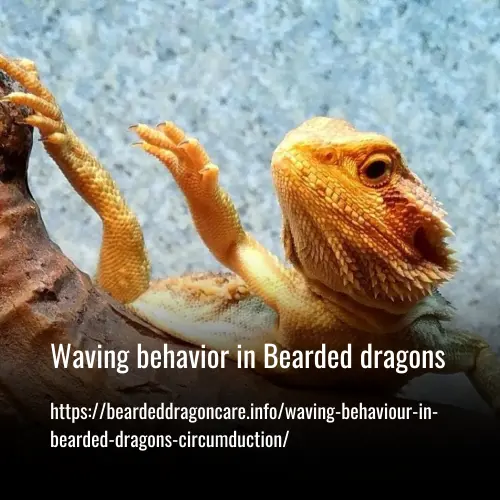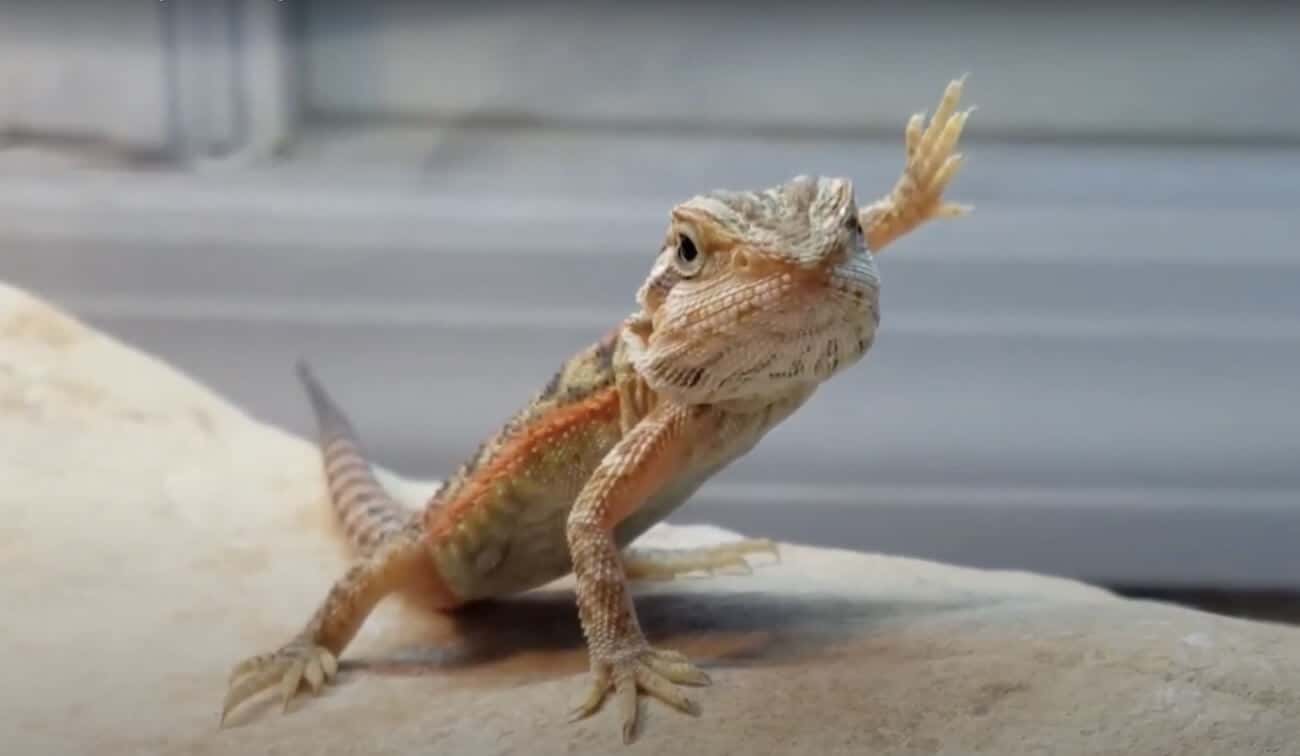Waving behavior in Bearded dragons (Circumduction)
This post contains affiliate links. As an Amazon Associate, we earn from qualifying purchases.
Keepers will very often see their Bearded dragon do arm movements that resemble a waving motion. Arm-waving motions in Bearded dragons, also referred to as circumduction, has a very specific role in the physiology of these animals.
The waving motion is characterized by a 360 degrees movement of a forelimb while it is lifted into the air – almost like a greeting gesture. Often both front limbs are used consecutively. Interestingly enough, it is said that this motion was the reason for calling the Bearded dragon the ‘Tata dragon’ – tata being a term used in some languages to say goodbye.

What is Waving?
Waving is an adorable behavior performed by Bearded Dragons, where they lift their arm in the air and rotate it in a slow circular motion. They may do this multiple times with each arm and it looks like they’re trying to greet you. It’s quite endearing and many owners respond to the wave with a wave back as if it was an exchange of greeting.
Though it looks friendly and harmless, there are some underlying implications as to why beardies might be performing this behavior. In some cases, particularly during times of stress or distress, waving could signify a sign of anxiety or fear. It could also mean that something isn’t right with your beardies such as pain or discomfort caused by malnutrition, disease, or illness.
Thus, when observing your Bearded Dragon display this behavior you should consult a veterinarian for proper diagnosis and treatment if needed. Besides being a sign of distress, waving can also indicate happiness so the context should always be carefully examined when interpreting why your friend is doing the wave!
Reasons for Waving
There are five main reasons why your beardie is waving.
1. Being Submissive to You
Bearded dragons express their submissiveness to humans in a variety of ways. They acknowledge our size and power by waving or bobbing their heads when they are around us. This is a sign that they understand their place in the world, and that they will not try to dominate us as they do with other bearded dragons or crickets.
In addition, your bearded dragon may even lick you occasionally to show its appreciation for being fed or given attention. Licking humans is another sign of submission, not unlike when cats groom each other.
2. Feeling Scared of Other Pets
If you have other pets in your home, then chances are that your bearded dragon might not be comfortable with their presence. Your beardie could feel scared of the other pets, which is why it is important to look out for signs of fear.
If your beardie runs and hides when the other pet comes near its cage, or shows submissiveness towards the other animal, then it is likely a sign that they are scared of them. This behavior can also be caused by simple curiosity or confusion on the part of your beardie rather than actual fear.
Over time, your beardie may begin to trust and understand that approaching animals do not pose a threat to it. For example, they might learn that cats love the heat emanating from their terrarium and won’t harm them in any way. If this is not possible, however, you will need to prevent your other pets from getting too close to the bearded dragon’s cage or appearing too threatening in any way.
3. Being Submissive of Other Pets
It’s common for some pets to show signs of submissiveness when around another animal that is larger than them. This doesn’t have to be a sign of fear, but rather a sign that they accept their position in life and the pack hierarchy.
If your beardie seems to be showing signs of submissiveness to other pets but doesn’t seem scared or overly intimidated by them, then there may not be any cause for concern.
4. Part of Mating Behavior
Mating behavior in some species includes a unique signal from the female – waving. When a female waves at a male during courtship or mating, it’s generally an act of submission.
This isn’t present in all meetings, so if you keep two mating pairs together and notice that the male is being aggressive towards the female, she might be waving as an indication of submission to try and stop the aggression.
5. Submissive to a Reflection
Bearded dragons wave for a variety of reasons, but one of the most common is when they see a reflection that looks like themselves. They may be showing their submissiveness to a bearded dragon that they don’t recognize and acknowledge their presence in order to let them know that they aren’t a threat.
Even though bearded dragons can recognize their own reflection, it’s not uncommon for them to wave at it, especially if they’re feeling scared or intimidated.

Common Misconceptions about Bearded Dragon Waving
1. Your dragon is waving “hello!”
One of the common misconceptions about bearded dragon waving is that your dragon is waving “hello!” at you. Unfortunately, this isn’t quite true. Even though we might like to consider that our lizards from distant places are giving us a feeble hello, bearded dragons do not view greetings in the same way that we humans do.
The bearded dragon waving instead communicates different messages. For example, they may be communicating a warning signal to other nearby lizards or even trying to get their owners’ attention when performing certain tasks or behaviors. They can also be using waving as a form of aggression when they are feeling threatened by another creature or object in their environment.
2. All bearded dragons wave
One of the most common misconceptions about bearded dragons is that they all wave, but this is simply not true. While waving is a sign that your bearded dragon may be feeling submission or discomfort, it does not necessarily mean that they are always doing it. Some may never wave and some could wave less often depending on the circumstances.
Bearded dragons who do not wave may simply feel very dominant and therefore don’t need to display submission behavior. They could also be very comfortable, happy, and healthy and that’s why they don’t feel the need to wave. Therefore, it’s important to remember that different beardies can have different behaviors and just because your beardie isn’t waving doesn’t mean something is wrong.
3. Only female bearded dragons wave
A common misconception about bearded dragon waving is that only female beardies wave to communicate their intentions. This isn’t true – male dragons also wave, but for different reasons.
Female bearded dragons will wave, then bob their heads up and down as a sign they are interested in mating. Males, however, will wave in submission to another bigger and stronger bearded dragon to indicate peaceful intentions or that they are not a threat.
Circumduction
This being said, waving behavior in Bearded dragons has nothing to do with saying goodbye. Circumduction is a well-noted and scientifically described posture in Bearded dragons and other reptiles. Arm waving is seen in pet and wild Bearded dragons.
It is believed to be a thermoregulatory mechanism (i.e. to control its body temperature) where less contact with the ground, e.g. when the feet are in the air, helps Bearded dragons to cool down. Waving behavior in Bearded dragons will most often be seen while they spend time in the basking area.
Other forms of arm waving movements
Although scientists have a good understanding of waving behavior in Bearded dragons, keepers will often see this being done in other scenarios too. Bearded dragons are often seen waving while hunting / stalking their prey or while communicating with other Bearded dragons.
While slower forms of wave movements are considered more docile, or even as a form of submission, faster forms are often seen in conflict situations. Faster forms of waving behavior in Bearded dragons are often seen while Bearded dragons protect their territories.
Should Bearded Dragon Waving Be a Concern?
Bearded dragon waving is not always a cause for concern, as it can be just a sign of submission or mild stress. However, it is important to keep an eye on your pet and take note of any other signs of possible health issues such as loss of appetite, inactivity, or changes in bowel movements that accompany the excessive waving.
It’s also important to make sure their enclosure setup is optimal to promote low-stress levels. Ensure that there are no elements that can cause your beardie some stress which may trigger excessive waving and affect their overall health. Identifying these elements and clearing them out before they lead to more serious problems will help ensure the well-being of your dragon.
FAQs
Is arm-waving considered a greeting for bearded dragons?
While people might wave hello to each other, bearded dragons don’t act in the same way. Arm waving in bearded dragons indicates submission, acknowledgment, fear, or confusion rather than a greeting.
Is head bobbing the same as waving for bearded dragons?
Bearded dragons utilize head bobbing and arm waving as two ways to communicate. Arm waving conveys submission while head bobbing presents dominance.
Do male and female bearded dragons wave their arms?
Yes, bearded dragons of both genders arm-wave! While it is more common in females, who use it to signal to males that they are willing to mate, males also arm waves in situations such as submission, acknowledgment, fear, and even confusion.
Should my bearded dragon wave?
Bearded dragons don’t need arm waving to be okay; if it’s set up in the right environment and is by themselves, then they won’t feel scared or anxious enough to arm wave.
Conclusion
In conclusion, bearded dragon circumduction has proven to be an incredibly fascinating behavior. Not only does it seem to be a form of complex communication between two dragons, but it’s also imperative for them to use their environment and body motions creatively in order to successfully mate.
Although this behavior can sometimes appear awkward or comical, there is truly so much more to behold when we study these creatures. So the next time you see bearded dragon waving behavior, remember that not only are they charming, but they may just be trying to say something important!
